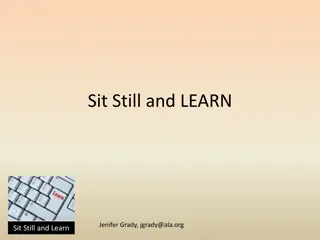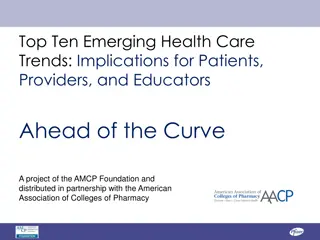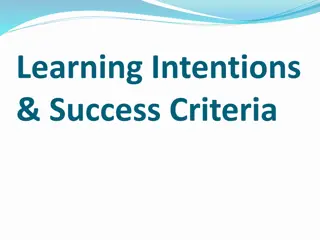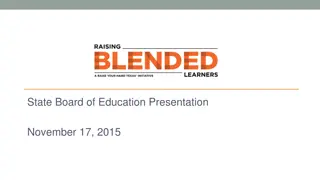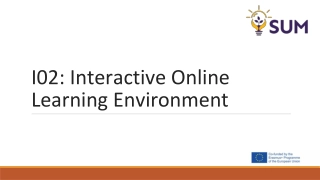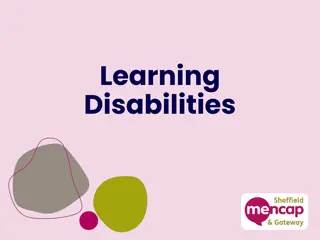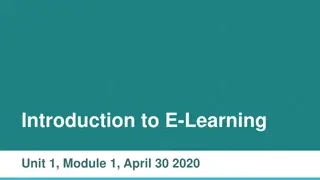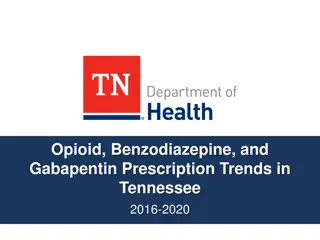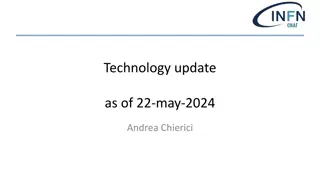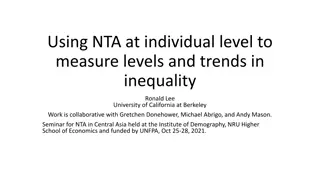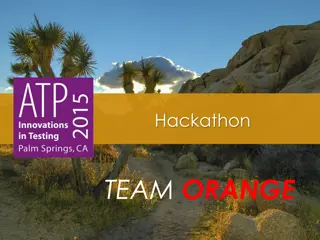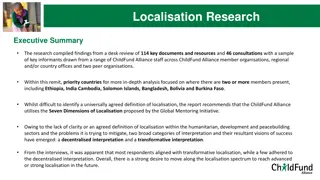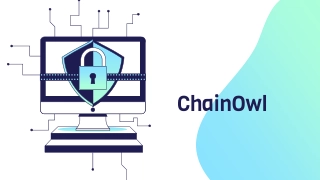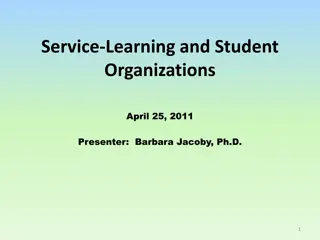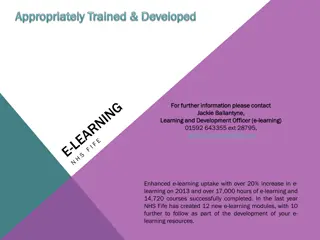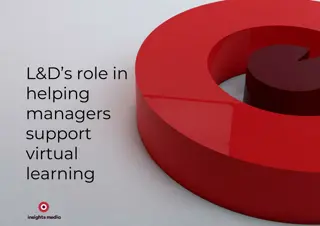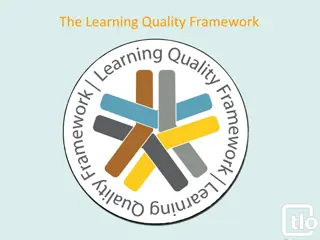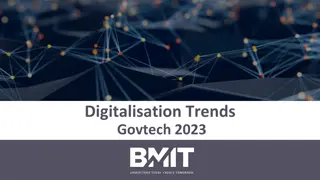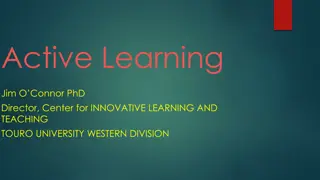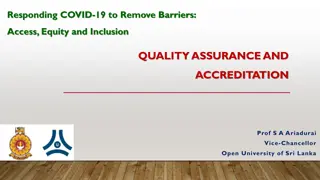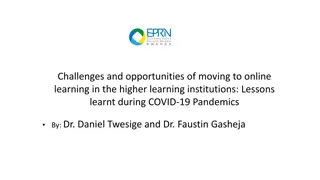Understanding K-12 Online Learning Trends and Challenges
Explore the landscape of K-12 online learning, including key findings, challenges, and emerging trends. Delve into topics such as access for students with disabilities, state policies, and the role of virtual schools. Gain insights into the current state and future directions of online education for K-12 students.
Download Presentation

Please find below an Image/Link to download the presentation.
The content on the website is provided AS IS for your information and personal use only. It may not be sold, licensed, or shared on other websites without obtaining consent from the author. Download presentation by click this link. If you encounter any issues during the download, it is possible that the publisher has removed the file from their server.
E N D
Presentation Transcript
OSEP Project Directors 2016 Jamie Basham; Sean Smith, KU Tracey Hall; Skip Stahl, CAST
Annual Publication 2015 1. Chapter One Understanding Transformative Change 2. Chapter Two State and Territory Policy Scan for Online Learning and Students with Disabilities 3. Chapter Three Special Education in Online Learning Environments (Placement & Teaching) 4. Chapter Four The Changing Structure and Roles within Online Education (States & Parents) 5. Chapter Five Special Topics: Access to Online Education, Data and Privacy, and Graduation
Center Priorities To investigate and identify: Current and emerging trends and issues related to the participation of all SWDs in online learning from kindergarten through grade 12 (K-12). Potential positive outcomes and negative consequences of online learning for SWDs. Promising approaches for effectively including students with disabilities in online learning. 3
Todays Flow 1. Present some overall perspectives on the field of policy, research, and practice. 2. Highlight some key findings and implications from two projects: State Policy Scan and Stakeholder Forums. 3. Highlight future research and dissemination activities. 4. Provide an opportunity for comments and questions.
The Numbers In SY 2014 15 state virtual schools in 24 states served over 462,000 students Six in ten public school students live in states that don t have state virtual schools, and these students are taking supplemental online courses Total estimate = 2,254.000 Estimated SWD online = 6% of enrollments Keeping Pace 2015
Important Definitions Full-time Virtual Students take all academic classes online; generally takes place in virtual schools or what are increasingly referred to as fully online schools. Blended Students learn part through online learning, with some element of student control over time, place, path, and/or pace and part at a supervised in a brick-and-mortar location away from home. Supplemental Students enroll in an online course to supplement another primary learning environment. Supplemental online learning usually occurs because the local school does not offer the course.
STATE OF K12 ONLINE LEARNING Online learning exists in every state across the nation and enrollment is growing. Issues across practice, teacher education, school leadership, and professional development present challenges. Inconsistencies exist throughout policy and practice, especially around disability service delivery.
The Potential 1. Online schools may offer students with disabilities more customizable learning placements and increased access to support materials and staff. 2. Online schools may be able to provide individualized academic programming for all students, including students with disabilities AND that the data generated will be interoperable and available to stakeholders. 3. Online schools may be able to allow students with disabilities to work digitally alongside their peers to a greater extent than currently possible.
Benefits Emerge Personalization or Student-Centered Learning made possible by: 1. real-time student progress data generated by networked learning systems which offer 2. flexible opportunities for students to acquire and demonstrate 3. competencies or proficiencies.
Benefits Emerge (2) Custom Learning Schedules: 1. Student control over time, place, path, and/or pace 2. Student control over subject or content 3. Increased opportunities for independent decision-making
Current Challenges 1. The delivery of Special Education (FAPE, LRE, etc.) is markedly different in online learning environments. 2. Full-time virtual settings present significant demands on parents as Learning Coaches 3. Data systems in online learning environments fail to store and/or are ill-equipped for sharing meaningful data about enrollment, progress, and persistence of students, especially students with disabilities.
Most of Todays Discussion State & Territory Policy Scan Stakeholder Forums
ENROLLMENT (Fully Online and State Sponsored Programs) Forum Findings No group has reliable enrollment data on SWD in online learning Enrollment and persistence are not tracked uniformly and data around these issues are not shared among Super, SEA, and vendors. Solution to attrition varies by group: Instructional efficiency (Vendor); Teacher monitoring (Super); Improved communication for problem-solving (SEA)
Access to Online Learning Does the state have guidance, documentation, regulation, or statutes that ensure online courses are accessible and open to enrollment by students with disabilities?
Who is Responsible for FAPE? Forum Findings State and Territory Scan Findings No agreement on who is responsible for providing FAPE/LRE: Vendors say parents Supers say teachers SEA say schools 75% have no or unclear evidence for what entity bears responsibility for FAPE.
IEP in Online Environments State and Territory Scan Findings 84%: no or unclear evidence of guidance for developing IEP in online environments. 87%: no or unclear evidence of required IEP review prior to enrollment.
IEP Contextualized (2) Forum Findings 1.SEA and Supers: Lack of evidence for best practices in the online environment; Employing a wait and see approach to rely on future research to lead them to best practices. 2. SEA: No evidence that practices in traditional settings readily transfer to online settings. 3. Supers: Are incorporating growth and outcome data to inform students IEP, monitoring, and instructional planning
DATA ACCESS AND PRIVACY 1. SEA: State data systems do not collect information necessary to characterize achievement, accessibility, and privacy of online instruction. 2. SEA/Vendor: The most important issue for online learning ... sharing, integrating, and using student response data. 3. Vendor: No interoperability among vendors; no standards for secure access across platforms.
Parent Participation State and Territory Scan Findings Forum Findings 1. SEA: Perception that vendor is responsible for defining parent roles. 1. SEA/Super: The online environment places more responsibilities on parents as educators. 100% have no or unclear guidance for parent involvement in online learning and students with disabilities. 1. Vendor: Aware of the need to increase family friendly features: portals, learning coach, assessment results.
Teacher Preparation State and Territory Scan Findings Does the state policy and/or guidance or requirements specify initial teacher licensure and/or endorsement in the area of online, blended, or digital learning? 6 states: yes with evidence Does this policy and/or guidance or requirements in online, blended, or digital learning mention students with disabilities? 3 of the 6 states: yes with evidence
Teacher Preparation (2) Forum Findings SEAs, Vendors, and Superintendents agree that 1.Teacher preparation is needed but they have no consensus about the specifics for working with SWD in online environments. 2.Currently IHEs are not performing this role. 3.Professional development is viewed as the responsibility of LEAs and vendors.
Revisiting the National Landscape Online learning is experiencing immense growth across the nation. The intersecting fields of practice, teacher education, policy, and leadership development are struggling with implementation. Large and growing inconsistencies exist throughout policy and practice.
Coming Soon Equity Matters 2016 Book Chapters Journal Articles White Papers
Visit us Online http://centerononlinelearning.org/





